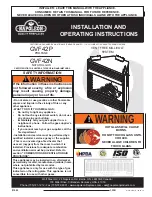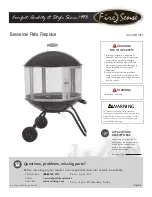
Direct Gas Make-Up Air
18
Installation
Piping
Guidelines for the installation of direct expansion (DX)
cooling coils have been provided to ensure proper
performance and longevity of the coils. These are
general guidelines that may have to be tailored to
meet the requirements of a specific installation.
Qualified personnel must perform the installation and
maintenance of any coil. Proper protective equipment is
recommended during the installation and maintenance
of the coil.
All field-brazing and welding must be performed using
high quality materials and an inert gas purge (such as
nitrogen) to reduce oxidation of the internal surface of
the coil.
All field-piping must be self-supporting and flexible
enough to allow for the thermal expansion of the coil
and piping.
1. Locate the Distributor(s)
A field-provided opening must be
created for the liquid line(s). The
distributor(s) are located behind the
distributor access panel.
2. Verify Nozzle Placement
Inspect the refrigerant distributor
and verify that the nozzle is in place.
The nozzle is generally held in place
by a retaining ring or is an integral
part of the distributor itself.
The nozzle is not a metering
device. A thermostatic
expansion valve (TXV) must
be field-supplied.
3. Install Suction Line
Install suction line(s) from the compressor(s) to the
suction connection(s) which are stubbed through the
side of the cabinet.
4. Install the Liquid Line and Thermostatic
Expansion Valve (TXV) (by others)
Liquid line openings vary by coil size and circuiting and
are field-supplied. Follow the TXV recommendations
for installation to avoid damaging the valve. If the valve
is externally equalized, use a tubing cutter to cut off
the plugged end of the factory installed equalizer line.
Use a de-burring tool to remove any loose metal from
the equalizer line and attach it to the TXV. If the valve is
internally equalized, the factory-installed equalizer line
can be left as is.
Distributor
Access Panel
Retainer
Ring
Nozzle
Distributor
General Installation
Expansion
Valve (by others)
Liquid Line
Thermal
Nozzle
Suction Header
Coil
Distributor
Equalizer Line
Suction Line
Remote Sensing Bulb
Straps
Suction Connection
5. Mount the TXV Sensing Bulb (by others)
Mount the TXV sensing bulb to the horizontal run of the
suction line at the TXV manufacturer’s recommended
position and insulate it.
6. Check System for Leaks
Pressurize the coil to 100 psig with dry nitrogen. Leave
the system pressurized for a minimum of 10 minutes.
If the system holds the pressure, the hook-up can be
considered leak free. If the pressure drops by 5 psig or
less, re-pressurize the system and wait another
10 minutes. If the pressure drops again, there is likely
one or more small leaks which must be located and
repaired. Pressure losses greater than 5 psig indicate a
large leak that must be isolated and repaired.
7. Evacuate and Charge the System
Use a vacuum pump to evacuate the system. Measure
the vacuum in the system using a micron gauge
located as far from the pump as possible. Evacuate the
system to 500 microns or less, and then close the valve
between the pump and the system. If the vacuum holds
to 500 microns or less for one minute, the system is
ready to be charged.
A steady rise in vacuum pressure indicates that moisture
is still present and that the system must be further
vacuumed until the moisture has been removed.
Failure to obtain a vacuum of 500 microns or less
indicates a great deal of moisture or a leak. Break the
vacuum with a charge of dry nitrogen and recheck for
leaks. If no leaks are found, continue vacuuming the coil
until the desired vacuum is reached.
8. Install the Drain Line
Connect an unobstructed drain line to the drain pan. A
trap must be provided for proper unit drainage.
All traps must be
installed below
the roof line or be
otherwise protected
from freezing.
Optional Split Direct Expansion (DX) Coil
6 in./min. (0.254 cm/sec)
6 in./min. (0.254 cm/sec)
Drain
Trap
















































